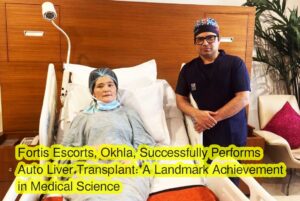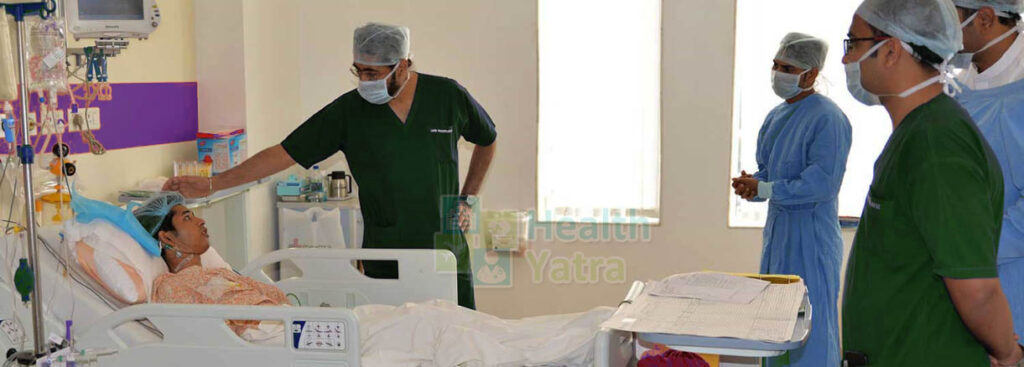Liver Surgery in India : Liver surgeries can be broadly classified into diagnostic and treatment based.
Liver Biopsy is a diagnostic procedure carried out to identify what is causing the Liver to go bad. It helps to tell us the status of liver condition. It is generally done after carrying out some blood tests and liver function tests that indicate a problem in the liver function. A small piece of liver tissue is obtained by inserting a needle through the abdomen. The tissue is then analyzed under the microscope to identify the exact cause of liver malfunction. If it is a tumor, then the type and stage of tumor can be found out.
Surgical treatment of liver diseases fall under three main procedures: Liver Resection, Liver Ablation and Liver Transplant. Let us understand each one separately.
Liver Resection is a removal of the diseased part of the liver to contain the spread of disease, or tumor. It is the commonest operation performed on the liver indicated for primary malignant tumors of the liver. The procedure gives a fruitful outcome if the tumor is localized. But it is generally not indicated if the tumor has spread all over the liver or if the tumor originates from cells other than the hepatocytes or liver cells (extrahepatic tumor). Benign tumors like adenoma cyst or hemangioma are also treated successfully by resection. During this procedure the tumor or diseased cells along with a few surrounding healthy cells are removed to eliminate any chances of recurrence. This procedure is also helpful in cases of malignant spread of colorectal cancer from the colon to the liver. Liver is a favorable site for metastasis as it has an extensive blood supply. Liver resection is usually not advised if the entire liver is affected, or there is liver cirrhosis.
Resection can further be classified in sub types depending upon the amount of tissue removed and the type of procedure used. It can be an open surgery or a laparoscopic (minimally invasive) resection. The Laparoscopic surgery involves making small incisions in the abdomen through which micro instruments are introduced to remove the diseases tissues with the help of video cameras. This procedure is particularly beneficial if the tumor is benign and located over the surface.
The Open Surgery performed under general anesthesia involves making a bigger incision in the abdominal wall, tying up of major blood vessels to minimize the amount of blood loss and maintain a bloodless field as far as possible. It can be resection of a small segment (segmentectomy) or an entire lobe (lobectomy) or one complete lobe with some portion of the other lobe also (extended segmentectomy). Since the open surgery involves a lot of muscle cutting and blood loss, the recovery period and length of stay in the hospital is longer.
Ablation is another surgical treatment for a diseased liver. Radiofrequency ablation is a newer technique that involves the introduction of probes through small punctures in the skin of the abdomen. The probes are guided to the target site with the help of CT scan or ultrasound. Once the target is reached high frequency current is passed through the needle probes which kills the tumor cells. It is helpful in localized tumors and can also be used in conjunction with resection.
Microwave ablation is yet another technique that has a similar basis but uses high power microwave energy to generate high temperatures to destroy the cancer tissue instead of electric currents. Cryosurgery involves injection of liquid nitrogen in the target areas of the liver and destroying the tumor cells by freezing them. It is helpful in cases of large tumors that may not be resectable.
Liver Transplant is a procedure of choice when the entire liver has to be replaced by a healthy liver. This is generally indicated in cases of acute or chronic full blown liver disease, tumor that has spread to whole of liver. It is a second most commonly performed procedure next to kidney transplant. Depending upon the source of the donor liver and site of transplant, it can be further subdivided. Orthotopic liver transplant is the replacement of the entire diseased liver with the healthy liver at the same site. Heterotopic liver transplant involves placing the healthy liver next to the diseased liver with reconnected blood vessels. This is done if there are chances of the affected liver to resume its normal function. In this case if the diseased liver recovers, the transplanted liver shrinks. In case the diseased liver does not recover, the new transplanted liver takes over the complete function and the affected liver shrinks away.
Cadaveric liver transplant is a procedure where the donor liver is obtained from a recently brain dead person whose liver was healthy. Live donor Liver transplant is a procedure in which a living person, usually a close relative of the recipient (e.g. Mother and child) is the donor. A small anatomical segment of the donor’s liver is resected along with its related blood supply and planted inside the recipient. In 6-8 weeks time the liver tissue regenerates to its full size in both donor and recipient and is able to perform all its functions. Reduced size Liver Transplant is a popular procedure in children. In this technique a portion of healthy liver is used to replace a whole diseased liver. It is possible to divide the liver into eight pieces, each supplied by a different set of blood vessels. Two of these pieces can save a patient in liver failure, especially if the patient is a child. It is therefore possible to transplant one liver into at least two patients and to transplant part of a liver from a living donor and have both donor and recipient survive.
Split liver transplant technique was introduced in the mid 1990’s and is a boon for many of those waiting for a liver. In this the donor liver is split into two along with their respective set of blood vessels. The smaller left lobe or left hemiliver is donated to a child and the larger right lobe or the right hemiliver is transplanted to an adult recipient. In this way one liver can be used to save two lives in cases where there is an emergency or waiting period is too long or the particular blood group and tissue type is rarer.
What are the postoperative outcomes?
Liver transplant and liver resection surgery techniques have undergone many refinements over the years to emerge as an excellent technique. With advancements in surgical instruments and imaging techniques, it is possible to perform these procedures with very less mortality. These procedures are safe, life saving and dependable. If all the post operative instructions are adhered to, then the graft lives as long as the patient lives. Most of the patients, both recipients and donors can bounce back to their normal life except for a few precautionary measures that have to be taken. A liver resection surgery takes about 3-5 hours and the patient is back to his normal life within 5 weeks. A Liver transplant surgery takes about 10 hours. The donor and the recipient remain in the intensive care for a few days and all their body functions like liver, cardiovascular, respiratory, kidney and blood sample are monitored. The recipient is checked repeatedly for any signs of graft rejection. They are then shifted to the ward and the donor is discharged within 5-7 days, and the recipient few days after that with a long list of instructions that are to be followed strictly.
What are the post operative dietary and medical precautions to be taken?
Resection surgery for tumor is followed up by chemotherapy and radiotherapy. Their frequency and dosage is reduced over time. For the transplant to be successful, the recipient is as responsible as the care giver and the entire transplant team. He should be aware that a slight laxity in following the doctor’s instructions can lead to rejection of graft. A slight modification in diet, certain changes in lifestyle, care to avoid infections and strictly adhering to the medication schedule can go a long way in having a good quality of life.
Immunosuppressants and antibiotics form the mainstay of the drug treatment. The timing and dosage of drugs to be taken should be followed as prescribed. Over a period of time the number of medications and their dosage is reduced but the immunosuppressants have to be taken life long.
Diet should consist of fresh fruits and vegetables that are thoroughly washed and cooked properly before consumption. As liver is important for absorption of vitamin D which is vital for proper bone formation, calcium supplements should be taken in addition to dietary calcium to avoid osteoporosis. Food containing listeria (a type of bacteria) should be avoided like unpasteurized cheese, mayonnaise, food stuffs containing raw eggs. These bacteria can interfere with the action of anti rejection drugs.
What are the general complications?
Common complications include, bleeding at the site where the blood vessels were attached, rejection, infection, recurrence of hepatitis. All these are avoidable with proper care and by following the Doctor’s orders strictly.
- Fortis Escorts, Okhla, Successfully Performs Auto Liver Transplant in India: A Landmark Achievement in Medical Science
 Auto Liver Transplant in India: At Fortis Escorts, Okhla, a momentous achievement has been realized as doctors successfully conducted an auto liver transplant on a 35-year-old woman hailing from Kyrgyzstan. The patient, Altynai Tentimishova, underwent initial examinations in Kyrgyzstan, where a diagnosis of Echinococcosis Multilocularis, a rare parasitic infection associated with a gradual liver tumor and subsequent organ damage, was …
Auto Liver Transplant in India: At Fortis Escorts, Okhla, a momentous achievement has been realized as doctors successfully conducted an auto liver transplant on a 35-year-old woman hailing from Kyrgyzstan. The patient, Altynai Tentimishova, underwent initial examinations in Kyrgyzstan, where a diagnosis of Echinococcosis Multilocularis, a rare parasitic infection associated with a gradual liver tumor and subsequent organ damage, was …
KEYWORDS : Top 10 liver transplant hospitals in india, liver transplant india cost, list of top Liver transplant surgeons in India 2024, list of top Liver transplant hospitals in India 2024,legal procedure for liver transplant in india, free liver transplant in india, liver transplant cost in india 2024, liver transplant in india success rate, best hospital for liver transplant in india, liver transplant in india news, Liver transplant hospitals in india, best government hospital for liver transplant in india, low cost liver transplant hospital in india, top liver transplant hospitals in india, best liver transplant hospital in south india, best liver transplant hospital in hyderabad, best liver transplant hospital in world, best liver transplant hospital in mumbai, liver transplant in delhi cost, top 10 liver transplant hospitals in india, liver transplant in government hospital delhi, free liver transplant in delhi, best liver transplant hospital in delhi, best liver transplant surgeon in delhi, liver transplant india cost, liver hospital in delhi, liver transplant in mumbai cost, best liver transplant hospital in mumbai, free liver transplant in mumbai, liver transplant in kem hospital mumbai, best liver transplant hospital in india, liver transplant government hospital in mumbai, liver donors in mumbai just now, global hospital liver transplant cost, partial liver transplant for cirrhosis, problems after liver transplant, longest liver transplant survivor, liver transplant survival rate by age, liver transplant success rate, home care after liver transplant, life after liver transplant

